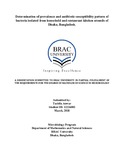Determination of prevalence and antibiotic susceptibility pattern of bacteria isolated from household and restaurant kitchen utensils of Dhaka, Bangladesh
Abstract
The kitchen is one of the most crucial areas that harbors and transmits infection. This study aimed at isolating, identifying, determining antibiotic susceptibility pattern and investigating antimicrobial activity of dishwashing liquid against the bacterial isolates collected from household and restaurant kitchen utensils (air, knife, spoon and cutting board) of Dhaka, Bangladesh. Sixteen (16) samples collected through sterile swabs were kept for enrichment into nutrient broth at 37ºC for 24 hours and were cultured on various selective media. Identification of bacteria was done through conventional biochemical tests according to Bergey’s Manual of Systematic Bacteriology. Antibiotic susceptibility pattern of all isolates were performed against ten commercial antibiotic discs by using Kirby-Bauer disc diffusion method. Minimum Inhibitory Concentration (MIC) of commercially used dishwasher was also performed using Broth Microdilution method against six selected isolates. A total of about 61 bacterial isolates were identified where Bacillus spp. showed the highest prevalence 18 (29.51%) followed by Vibrio spp. 17 (27.87%), Staphylococcus spp. 13 (21.31%), Klebsiella spp. 6 (9.84%), Shigella spp. 4 (6.56%), Salmonella spp. 2 (3.28%), and E.coli 1 (1.63%). Antibiotic susceptibility pattern of the bacterial isolates showed that almost all of the isolates were resistant to at least two antibiotics. Among the 61 isolates, 72.13% were found resistant to more than two antibiotics and 27.87% were found resistant to two antibiotics. Highest resistance percentage of the isolates were observed to penicillin (83.61%) followed by cefixime (60.65%), amoxicillin and SXT (50.82%), rifampicin (49.18%), cefepime (40.98%), chloramphenicol (18.03%), tetracycline (14.71%), ciprofloxacin (6.56%) and gentamycin (1.64%). Broth Microdilution assay revealed that Shigella spp. showed the highest MIC value (400μl of stock solution) and Staphylococcus spp. showed the lowest MIC value (190μl of stock solution). Besides, Escherichia coli, Salmonella spp., Vibrio spp. and Bacillus spp. showed the MIC values 250μl, 300μl, 300μl and 250μl of stock solution respectively. These results indicate that, household and restaurant kitchens can easily be contaminated with a variety of bacterial contaminants. Findings of this study also indicated the presence of multi-drug resistant bacterial strains in kitchen utensils which can serve as potential source of food-borne diseases. Regular cleaning of kitchen utensils, use of dishwashing liquid and public awareness on personal hygiene can help minimize the spread of food-borne diseases from kitchen utensils.

